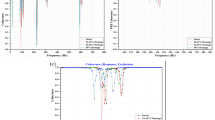Abstract
The current paper presents a method to update the baseline model and detect cracks in tapered cantilever pipe-type beams which are restrained by a translational and rotational spring with a tip mass at the free end using natural frequencies. Modal parameters of intact beam are obtained by applying boundary conditions to a general solution for tapered beam. The equivalent bending stiffness is used to calculate natural frequencies of cracked beams. An experimental study is carried out. The translational and rotational spring constants are updated to establish a baseline model using a neural network. Then, several numerical analyses of the cracked beams are carried out to extract the natural frequencies, and those are used in constructing the training patterns of a neural network. The committee of neural networks are employed to identify the cracks. The crack identifications are carried out for the 3 damage cases, and it is found that the estimated crack locations and sizes agree reasonably well with the exact values.









Similar content being viewed by others
References
Dilena, M., Dell’Oste, M. F., & Morassi, A. (2011). Detecting cracks in pipes filled with fluid from changes in natural frequencies. Mechanical Systems and Signal Processing, 25, 3186–3197.
Gorman, D. J. (1975). Free vibration analysis of beams and shafts. New York: Wiley.
Lee, J. W. (2016). Crack identification method for tapered cantilever pipe-type beam using natural frequencies. International Journal of Steel Structures, 16, 467–476.
Lee, J. W., Kim, S. R., & Huh, Y. C. (2014). Pipe crack identification based on the energy method and committee of neural networks. International Journal of Steel Structures, 14, 345–354.
Matsuoka, K. (1992). Noise injection into inputs in back-propagation. IEEE Transactions on Systems, Man and Cybernetics, 22, 436–440.
Naniwadekar, M. R., Naik, S. S., & Maiti, S. K. (2008). On prediction of crack in different orientations in pipe using frequency based approach. Mechanical Systems Signal Processing, 22, 693–708.
Sinou, J. J. (2012). On the use of non-linear vibrations and the anti-resonances of higher-order frequency response functions for crack detection in pipeline beam. Mechanical Research Communications, 43, 87–95.
Wang, Y. M., Chen, X. F., & He, Z. J. (2011). Daubechies wavelet finite element method and genetic algorithm for detection of pipe crack. Nondestructive Test Evaluation, 26, 87–99.
Ye, J., He, Y., Chen, X., Zhai, Z., Wang, Y., & He, Z. (2010). Pipe crack identification based on finite element method of second generation wavelets. Mechanical Systems and Signal Processing, 24, 379–393.
Acknowledgements
This work was supported by the National Research Foundation of Korea (NRF) grant funded by the Korea Government (MSIT) (No. 2017R1A2B4006722).
Author information
Authors and Affiliations
Corresponding author
Rights and permissions
About this article
Cite this article
Lee, JW. Model Updating and Crack Detection for Elastically Restrained Tapered Cantilever-Type Beam Using Natural Frequencies. Int J Steel Struct 19, 413–421 (2019). https://doi.org/10.1007/s13296-018-0128-5
Received:
Accepted:
Published:
Issue Date:
DOI: https://doi.org/10.1007/s13296-018-0128-5




